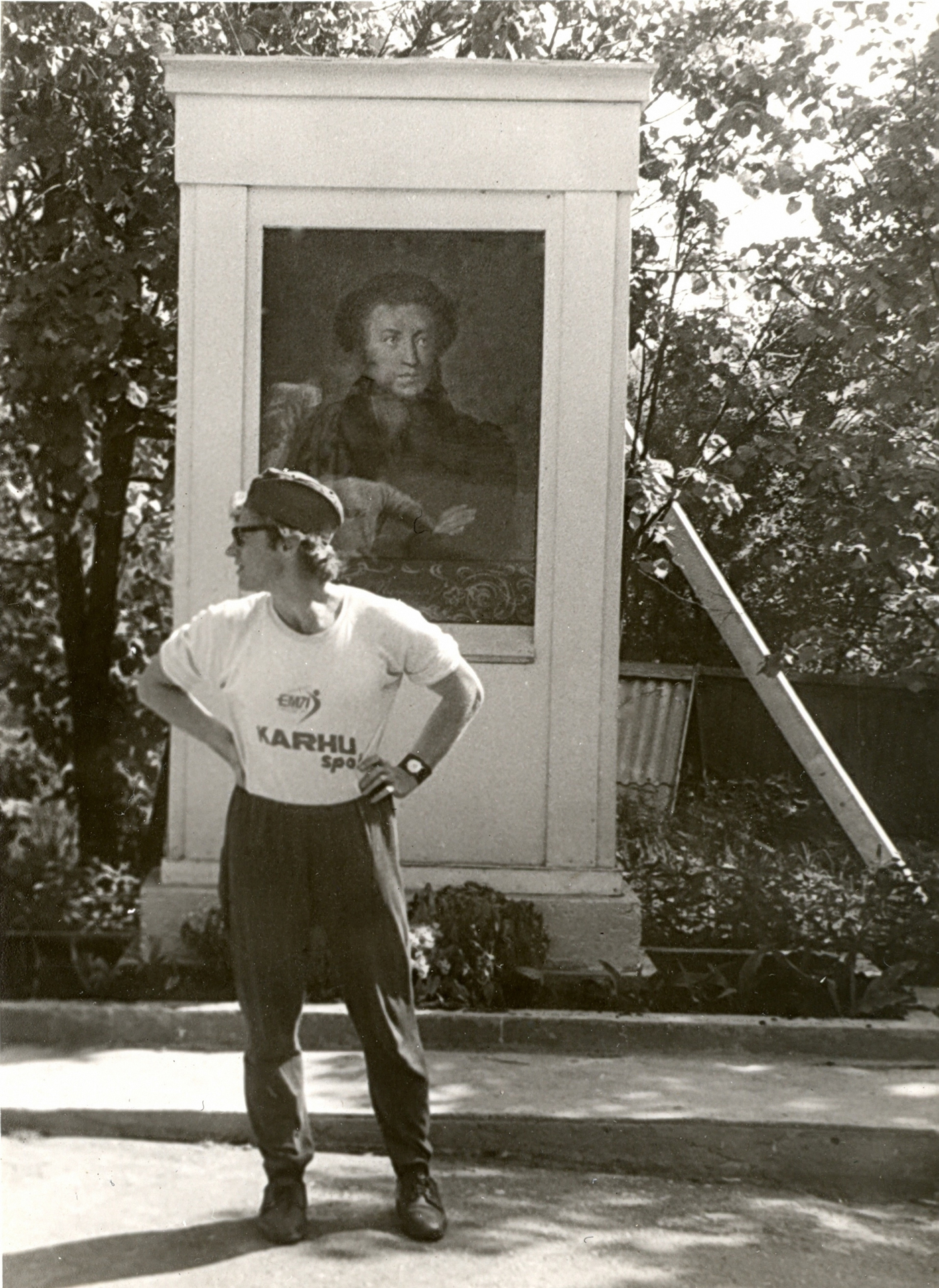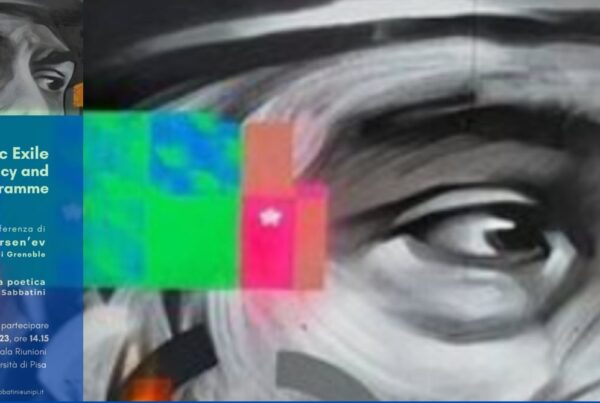
Aleksandr Kondratov.
Title:
Zdravstvui, ad! [Hello, hell!]
Author: Aleksandr Mikhajlovich Kondratov (1937-1993)
Years of writing: 1958-1967 (from frontispiece)
Place: Leningrad
Year of first publication: in 1996, 4 chapters were published (out of the original 13), “Novoe Literaturnoe Obozrenie”, 18, 1996.
Description:
Midway between autofiction and autobiography, the novel Zdravstvui, ad! [Hello, hell!] is the most famous work of the poet and prose writer Aleksandr Kondratov (1937-1993), a member of the Philologist group and one of the greatest post-war experimenters.
Divided into thirteen chapters and constructed partly on the model of Dante’s Commedia, this ‘lyrical diary’ (as it is defined in the subtitle) is a journey into the underworld of the Soviet universe. The journey through nine hellish circles is erratic and real but also metaphysical. Each circle is set in a different city, which are all perfectly recognisable despite the alteration of their original names: Omsk (in the novel becomes Khamsk), Voronezh (Uronezh), Belgorod (Elgorod), Kuibyshev (Khuibyshev), Leningrad (Kotlograd, the Furnace City) and Moscow (Glavkotel, The Great Furnace), also known as the ‘City of Dis’ (cf. Kotomko 1996: 148).
This Soviet hell is asphyxiating; the un-liveability of the two capitals represented by their fictitious place names, in which both include the term kotel [boiler], which may also be a reference to one of the most common public jobs held by exponents of the ‘Second Culture’: that of kochegar [stoker].
The novel, which lacks a traditional plot, is a parodic, grotesque, and dark account of the alienating Soviet byt and of the events in the author’s life between 1958 and 1967.
It bears the influence of Henry Miller’s Tropic of Cancer, a work banned in the USSR (and elsewhere) which Kondratov was intending to translate in these years. The translation was eventually finished a few months before his death (cf. Kondratov 1995: 157-158).
Kondratov was an extremely successful popular writer (he was the author of dozens of books translated into many languages, including Italian) and at the same time a frequent visitor to the underground circles of Moscow and especially Leningrad, where he was known by the pseudonym Sandy Konrad (cf. Iocca 2015: 114-ff. ), Kondratov populates his novel with characters he met in the circles he frequented, figures whose names are grotesquely mispronounced giving the novel an irreverent, carnivalesque feel: Faustovskii, Vrein, Osia Vrotskii, Popybshev, Ebitov (cf. Kondratov 1996: 101-102).
Zdravstvui, ad! is a test piece for the innovations and leitmotifs used by the author in his prose production (thousands of pages remain unpublished), giving voice to an individual in revolt against a society that seeks to crush, normalise and reproduce a system of hierarchy more rigid than the Hindu caste system (cf. ibid.: 102-103): at the top of the inverted pyramid of the Soviet system are the workers who have failed to free themselves from the evils found in other states or their own past.
In opposition to Soviet society, based, as Kondratov saw it, on materialism, the juxtaposition of different stylistic elements represents a bid for freedom. His retaliates against literary classics, accusing them of avoiding and suffocating sexuality and tells the story of a murderous revolt against a neighbour, led by a new messiah in apocalyptic tones. The Christian subtext, an indication of the spiritual degradation of Leningrad, takes over in the final chapters of the novel.
A text such as Zdravstvui, ad!, still unpublished in its entirety, offers the opportunity to make some general observations about the nature of samizdat texts. As testified by friends and acquaintances, Kondratov’s made recurrent modifications to his texts (cf. Nikol’skaia 2015: 527), meaning that each typescript that, for various reasons, did not manage to find its way to publication, is unique, in that it was finished de facto. Precisely because of the unpublished status of samizdat texts, they were liable to infinite modifications, remaining evanescent and variable. The author was free to reuse successful passages in other works and it is often impossible to date the final drafting of a work with absolute precision. In this case, there are several testimonies from colleagues and friends who speak of the drafting of the work (cf. Losev 1995: web) and of the wide circulation of the typescript of Zdravstvui, ad! and other prose by Sandy Konrad in the restricted circles of the samizdat of the time (cf. Losev 1994: web; Anonymous 1984: 64).
Federico Iocca
[30th June 2021]
Translation by Marta Capossela
Bibliography
- Anonymous [Khvostenko A.?], Aleksandr Kondratov zhivet…,“Ekho”, 13 (1984): 64.
- Iocca F., Aleksandr Kondratov e le sue ipostasi: un “avanguardista accademico” nella Leningrado underground, “Enthymema”, 12 (2015): 109-112, https://riviste.unimi.it/index.php/enthymema/article/view/4948, online (last accessed: 30/06/2021).
- Kondratov A., Tropik raka: Parizh-Amerika-Rossiia (fragmenty iz knigi “Trudno byt’ jogom”), “Urbi”, 5 (1995): 157-158.
- Kondratov A., Zdravstvui, ad!. Liricheskii dnevnik 1957-1967 (Izbrannye glavy: I, II, IV, XI), “Novoe Literaturnoe Obozrenie”, 18 (1996): 89-130.
- Kotomko N., Posleslovie k adu, “Novoe Literaturnoe Obozrenie”, 18 (1996): 148-149.
- Losev L., Homo ludens umer (iz knigi “Meandr”), “Zvezda”, 8 (1994): 145-151.
- Losev L., Tulupy my, “Novoe Literaturnoe Obozrenie”, 14 (1995), https://kkk-bluelagoon.ru/tom1/philolog.htm#1 online (last accessed: 30/06/2021).
- Nikol’skaia, T., Vspominaia Sėndi Konrada, “Russian Literature”, 78 (2015): 525-528.
To cite this article:
Federico Iocca, Zdravstvui, ad! (A. Kondratov), in Voci libere in URSS. Letteratura, pensiero, arti indipendenti in Unione Sovietica e gli echi in Occidente (1953-1991), a cura di C. Pieralli, M. Sabbatini, Firenze University Press, Firenze 2021-, <vocilibereurss.fupress.net>.
eISBN 978-88-5518-463-2
© 2021 Author(s)
Content license: CC BY 4.0




